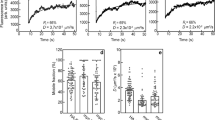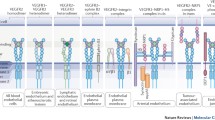Abstract
Vascular endothelial growth factor (VEGF) regulates blood vessel formation by binding to the receptor tyrosine kinases VEGF receptor-1 (Flt-1) or VEGF receptor-2 (KDR) and to the structurally unrelated neuropilins. As exon 7-containing isoforms of VEGF bind to heparin, angiogenesis may be modulated by heparin/heparan sulfate. We analyzed the effect of heparin on VEGF165-binding and activation of VEGF receptor-1 in porcine aortic endothelial cells, which lack expression of VEGF receptor-2 and neuropilins. Heparin decreased binding of 125I-VEGF to 50% at 5 μg/ml and cross-linking of 125I-VEGF to VEGF receptor-1 on intact cells was similarly decreased. Schatchard analyses showed that the affinity for binding of 125I-VEGF to VEGF receptor-1 was decreased in the presence of heparin. In contrast, VEGF receptor-1 kinase activity was elevated when cells were treated simultaneously with VEGF and heparin. In accordance, VEGF-induced tyrosine phosphorylation of phospholipase Cγ (PLCγ) and DNA synthesis were augmented by heparin. However, basal PLCγ tyrosine phosphorylation and DNA synthesis levels were to some extent increased by incubation of cells with heparin alone. We conclude that although heparin decreases binding of VEGF to VEGF receptor-1, the remaining binding results in more efficient kinase activation. Taken together, there is no loss of VEGF/VEGF receptor-1 function in the presence of heparin.
Similar content being viewed by others
References
Ferrara N. Vascular endothelial growth factor: Molecular and biological aspects. Curr Top Microbiol Immunol 1999; 237: 1–30.
Shibuya M, Ito N, Claesson-Welsh L. Structure and function of vascular endothelial growth factor receptor-1 and-2. Curr Top Microbiol Immunol 1999; 237: 59–83.
Soker S, Takashima S, Miao HQ et al. Neuropilin-1 is expressed by endothelial and tumor cells as an isoform-specific receptor for vascular endothelial growth factor. Cell 1998; 92: 735–45.
Risau W. Development and differentiation of endothelium. Kidney Int Suppl 1998; 67: S3–6.
Neufeld G, Cohen T, Gengrinovitch S, Poltorak Z. Vascular endothelial growth factor (VEGF) and its receptors. FASEB J 1999; 13: 9–22.
Shalaby F, Rossant J, Yamaguchi TP et al. Failure of blood-island formation and vasculogenesis in Flk-1-deficient mice. Nature 1995; 376: 62–6.
Carmeliet P, Ferreira V, Breier G et al. Abnormal blood vessel development and lethality in embryos lacking a single VEGF allele. Nature 1996; 380: 435–9.
Ferrara N, Carver-Moore K, Chen H et al. Heterozygous embryonic lethality induced by targeted inactivation of the VEGF gene. Nature 1996; 380: 439–42.
Fong GH, Rossant J, Gertsenstein M, Breitman ML. Role of the Flt-1 receptor tyrosine kinase in regulating the assembly of vascular endothelium. Nature 1995; 376: 66–70.
Faller DV. Endothelial cell responses to hypoxic stress. Clin Exp Pharmacol Physiol 1999; 26: 74–84.
Landgren E, Schiller P, Cao Y, Claesson-Welsh L. Placenta growth factor stimulates MAP kinase and mitogenicity but not phospholipase C-gamma and migration of endothelial cells expressing Flt 1. Oncogene 1998; 16: 359–67.
Vaisman N, Gospodarowicz D, Neufeld G. Characterization of the receptors for vascular endothelial growth factor. J Biol Chem 1990; 265: 19461–6.
Waltenberger J, Claesson-Welsh L, Siegbahn A et al. Different signal transduction properties of KDR and Flt 1, two receptors for vascular endothelial growth factor. J Biol Chem 1994; 269: 26988–95.
Gitay-Goren H, Cohen T, Tessler S et al. Selective binding of VEGF121 to one of the three vascular endothelial growth factor receptors of vascular endothelial cells. J Biol Chem 1996; 271: 5519–23.
Dougher AM, Wasserstrom H, Torley L et al. Identification of a heparin binding peptide on the extracellular domain of the KDR VEGF receptor. Growth Factors 1997; 14: 257–68.
Keyt BA, Berleau LT, Nguyen HV et al. The carboxyl-terminal domain (111–165) of vascular endothelial growth factor is critical for its mitogenic potency. J Biol Chem 1996; 271: 7788–95.
Roeckl W, Hecht D, Sztajer H et al. Differential binding characteristics and cellular inhibition by soluble VEGF receptors 1 and 2. Exp Cell Res 1998; 241: 161–70.
Kaplan JB, Sridharan L, Zaccardi JA et al. Characterization of a soluble vascular endothelial growth factor receptor-immunoglobulin chimera. Growth Factors 1997; 14: 243–56.
Tessler S, Rockwell P, Hicklin D et al. Heparin modulates the interaction of VEGF165 with soluble and cell associated flk-1 receptors. J Biol Chem 1994; 269: 12456–61.
Cohen T, Gitay-Goren H, Sharon R et al. VEGF121, a vascular endothelial growth factor (VEGF) isoform lacking heparin binding ability, requires cell-surface heparan sulfates for efficient binding to the VEGF receptors of human melanoma cells. J Biol Chem 1995; 270: 11322–6.
Terman B, Khandke L, Dougher-Vermazan M et al. VEGF receptor subtypes KDR and FLT1 show different sensitivities to heparin and placenta growth factor. Growth Factors 1994; 11: 187–95.
Soker S, Goldstaub D, Svahn CM et al. Variations in the size and sulfation of heparin modulate the effect of heparin on the binding of VEGF165 to its receptors. Biochem Biophys Res Commun 1994; 203: 1339–47.
Guimond S, Maccarana M, Olwin BB et al. Activating and inhibitory heparin sequences for FGF-2 (basic FGF). Distinct requirements for FGF-1, FGF-2, and FGF-4. J Biol Chem 1993; 268: 23906–14.
Schlessinger J, Lax I, and Lemmon M. Regulation of growth factor activation by proteoglycans: What is the role of the low affinity receptors? Cell 1995; 83: 357–60.
Hahnenberger R, Jakobson AM, Ansari A et al. Low-sulphated oligosaccharides derived from heparan sulphate inhibit normal angiogenesis. Glycobiology 1993; 3: 567–73.
Author information
Authors and Affiliations
Rights and permissions
About this article
Cite this article
Ito, N., Claesson-Welsh, L. Dual effects of heparin on VEGF binding to VEGF receptor-1 and transduction of biological responses. Angiogenesis 3, 159–166 (1999). https://doi.org/10.1023/A:1009008926710
Issue Date:
DOI: https://doi.org/10.1023/A:1009008926710




